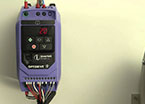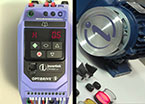VFD Fundamentals
What is a Variable Frequency Drive?
A variable frequency drive is used to control the speed of three phase AC Induction motors.
Full ArticleVariable Frequency Drives in Practice
This article describes how a variable frequency drive is put together. The IGBTs and rectifiers are usually in a single power module which is mounted on a heatsink, normally cooled by a fan which switches on when needed.
Full ArticleSerial Communications
Serial communications are all around us, from our USB memory sticks to the Internet. Most variable frequency drives include a serial interface, which can be used instead of hard wiring to control as well as set up the drive. Serial communications need some form of definition in order for equipment to be compatible.
Full ArticleMotors, Motors, Motors
Induction motors have long been the simple, reliable solution for power in industry. Recently however, new technologies and the need for ever increased efficiency have encouraged the development of different types of motors that can be driven by variable frequency drives.
Full ArticleVector Control
‘Vector Control’ is used by drive salesmen in the same way ‘Turbo’ used to be by car salesmen, but just what is Vector control?
Full ArticleTorque Control and Master Slave Operation
Most applications of drives are not concerned with the actual speed of the motor, but with the result. In a fan application, the output frequency of the drive will be varied (either manually or as part of a control system) to control the flow rate, pressure or temperature.
Full ArticlePower Factor, Form Factor and RMS
When a motor runs directly from the mains, it draws a load current which supplies the torque, and a magnetising, or reactive current that develops the magnetic field. This current flows back and forth in the motor and cables, but does no useful work, and in small installations is not metered or paid for. The ratio between the total and reactive current is known as the power factor. Many other loads also draw reactive currents, so it makes sense to minimise and correct the power factor if possible. Power factor correction equipment can be used in larger installations.
Full ArticleSetting Setpoints
What’s a setpoint? It’s the frequency you want to be supplied by the drive to the motor. Remember you don’t usually control the speed of the motor, that’s determined by the applied frequency less the slip (the small speed reduction dependent on load) and of course the number of pole pairs. So a four pole motor, fully loaded, supplied with a 25Hz frequency will run at about 700rpm, while a two pole machine will run at 1400rpm.
Full Article




















